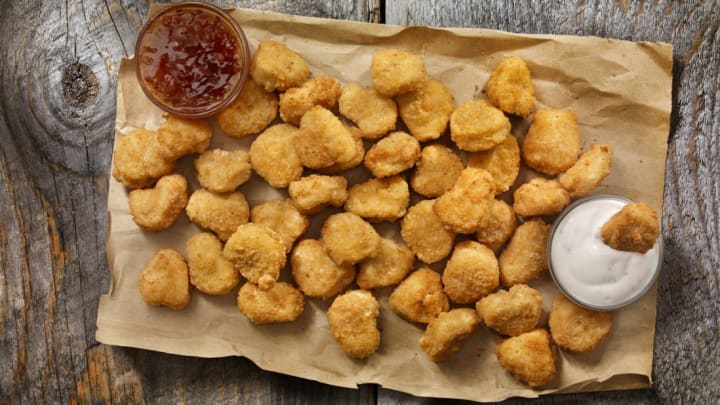For decades, the chicken nugget has been a staple of fast food menus and grocery store frozen food aisles. But contrary to popular belief, these fried bits of poultry deliciousness weren't invented by McDonald's. Like so many other dishes before it, parts of the nuggets origin story are contested, but most sources agree that it all began with Robert C. Baker, a poultry and food science professor at Cornell University.
In the 1960s, Baker was attempting to find new ways to make chicken exciting again for Americans. During World War II, the U.S. government had created a rationing system, similar to the one that was being used in the UK. The list of rationed items was extensive and included foods like beef, pork, sugar, oil, and canned or preserved meats. While cheese and cream would later be added to the list of rationed items, milk, eggs, and poultry were not—which made chicken dishes a popular dinner choice for many households during the war.
After the war, according to Slate, demand for poultry saw a steep decline because chickens were typically sold as whole birds, which could be inconvenient for families. Some butchers were willing to cut their chickens into smaller pieces to make it easier to cook, but Baker—who had a reputation as a food innovator (he was the man behind frozen French toast and chicken hot dogs, and was working on ways to increase the value of chickens once they were no longer able to lay eggs)—was interested in creating a way to simplify the process completely.
First, Baker created what was known as a chicken stick—ground up chicken that was breaded in an egg batter then frozen. He realized he could solve some of the issues food scientists were facing by removing the skin and by making a batter that could be fried even after it was frozen. He sent his chicken sticks to local grocery stores, where they were an instant hit, with some selling up to 200 boxes per week.
But Baker felt there were ways his process could be improved upon and refined, and he was happy to let others give it a try. Instead of patenting his chicken sticks, Baker published his entire process for creating them in Agricultural Economics Research and had copies sent to poultry companies and food scientists throughout the United States.
"Robert C. Baker was both a product of changes going on in the poultry world and a driver of those changes,” anthropologist Steve Striffler, author of Chicken: The Dangerous Transformation of America’s Favorite Food, said. “Industry leaders quickly realized that real profit would not so much come from producing more chicken, but by doing more to chicken. Hence, further processing.”
According to History.com, Baker’s creation could not have come at a better time. Beginning in the 1970s, scientists and the U.S. government began suggesting that Americans cut down on their consumption of red meat, as too much of it could lead to such health problems as high cholesterol. Chicken was promoted as a healthy alternative.
While there's no direct source to confirm that McDonald’s Corporation founder Ray Kroc read Baker's original process report, it was clear that the fast food magnate wanted to capitalize on this chicken push. Kroc wanted to create a chicken product that would offer convenience—"a boneless piece of chicken, [sold] almost like French fries," explained McDonald’s chairman Fred Turner.
While McDonald’s executive chef René Arend played around with some potential recipes, Kroc enlisted the help of meat supplier Keystone Foods to come up with a way to automate the chicken-chopping process. He also reached out to Gorton’s, the company known for its fish sticks—which had helped McDonald’s when the company was developing the Filet-O-Fish—to create a batter for these bite-sized pieces of chicken. In 1981, Mickey D’s officially introduced their Chicken McNuggets, which turned out to be one of the most successful new product launches in fast food history. Even today, McNuggets still account for about 10 percent of the restaurant’s sales.
Baker, meanwhile, went on to found Cornell University’s Institute for Food Science and Marketing in 1970 and serve as its very first director. He also helped invent a chicken deboning machine. Though he received no monetary benefit from the success of the chicken nuggets he helped to create, his place in poultry history did lead to him becoming known as the "George Washington Carver of Chicken."
Have you got a Big Question you'd like us to answer? If so, let us know by emailing us at bigquestions@mentalfloss.com.
